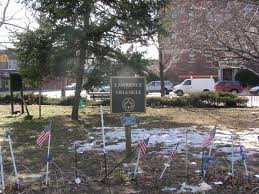-
Private Edward M. McKee was a native of Queens who was killed in World War I. McKee grew up at 67 North Sixth Avenue in Whitestone, and joined the army when the United States entered the war. He served in Company I of the 326th Infantry regiment, and tragically died of wounds on October 15, 1918, just 27 days before Read more...
-
This park is named to honor Guglielmo Marconi (1874-1937), an Italian scientist who pioneered the wireless telegraph and subsequently developed the modern radio. Born in Bologna, Italy, Marconi was the son of an Italian businessman, Joseph, and an Irish physicist, Annie Jameson. From an early age, Guglielmo displayed exceptional intelligence and an interest in electricity and physics. When his family Read more...
-
This park honors Major John W. Mark, who lost his life fighting for the U.S. Army in World War I (1914-1918). Mark, a member of the 302nd Engineers, served throughout Europe at Soissons, Chateau Thierry, and Vesle. Now the largest and most densely populated community in central Queens, the area derives its name from the Jameco (“beaver”) Native Americans, who Read more...
-
This park is named in honor of Captain Gerald MacDonald (1882-1929), a World War I soldier and former resident of Forest Hills, Queens. Aptly born in the town of Warrior Run, Pennsylvania, MacDonald served in the 22nd and 12th Engineers in World War I. As an army engineer, not only was he in the front line of battle, but also Read more...
-
Located on 52nd Avenue between 248th Street and Marathon Parkway, this park honors the extraordinary achievements of pioneering French microbiologist Louis Pasteur (1822-1895). The son of a tanner, Pasteur was raised in Arbois, France. He received his primary education at the Royal College of Besancon, which awarded him the bachelier des lettres in 1840 and the baccalaureat des sciences in Read more...
-
This playground, which opened in 1954, serves the students at the adjoining P.S. 15 and the residents of Springfield Gardens. Named after the nearby Long Island Rail Road station, Locust Manor first appeared as a name of a local development project in 1906. Springfield Gardens was formerly known as “Spring Fields” because of its many ponds and creeks. The landscape Read more...
-
This small triangle near Flushing Hospital Medical Center honors General George J. Lawrence, Jr. (1881-1949), a doctor, soldier, banker and athlete, whose extraordinary career made him a leader in many major Flushing institutions. He graduated from St. Francis College in Brooklyn in 1902, and continued his pursuits at the University of Pennsylvania, where he excelled not only in his medical Read more...
-
This triangle honors Luke J. Lang (c.1894-1917), a soldier who gave his life in World War I (1914-1918). Born in 1894, Lang lived on Bleecker Street in the nearby neighborhood of Ridgewood, and he worked as a printer at J.E. Hetsch on Duane Street in Manhattan. Lang enlisted to fight in World War I in June 1917. The details of Read more...
-
Located on 230th Street between 57th Avenue and 57th Road, this playground honors the contributions of Swedish botanist Carolus Linnaeus (1707-1778). The scientific community recognizes Linnaeus as the founder of the binomial system of species classification, a method of assigning names to birds and animals. Linnaeus was born in South Rashult, Sweden, the son of a minister. At the age Read more...
-
This square, located in the Queens neighborhood of Murray Hill, honors Corporal William A. Leonard (1889-1918), a Flushing native who lost his life fighting in World War I. Leonard, a member of the 107th Infantry Regiment, 27th Infantry Division in the First World War (1914-1918), was killed in action on July 16, 1918, in Flanders, Belgium. As a boy, Leonard Read more...








